SMITH HISTORY BLOG: Prime Parking
by Chris Woodworth
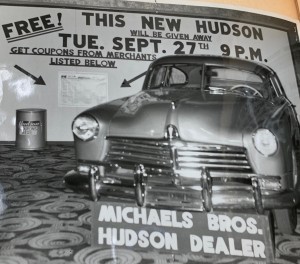
Photograph of Hudson Automobile parked in Lobby of Smith, as part of a giveaway program with other businesses. This photograph appears in Gerald Fowler’s Scrapbook, housed in the Geneva Historical Society Archives.
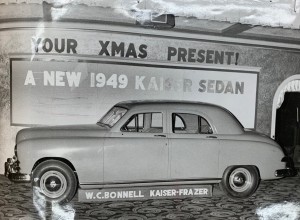
Photograph of 1949 Kaiser Automobile parked in Lobby of Smith. This photograph appears in Gerald Fowler’s Scrapbook, housed in the Geneva Historical Society Archives.
Imagine our surprise when flipping the pages of Gerald Fowler’s Scrapbook to discover several photographs of cars parked IN THE LOBBY! It appears that in the 1940s, and perhaps into the early 1950s, while Fowler was the manager, area car dealers teamed up with The Smith (then Schines Geneva Theatre) as well as other local businesses, for automobile giveaways. You can see the iconic carpet under the wheels of these cars, parked just outside the auditorium. How on earth did they manage to drive those cars through the front doors, given the placement of the old box office? If you know, we’d love to hear from you!
Today, there is much more parking downtown than there would have been in the mid-twentieth century. Urban renewal brought about vast changes to Seneca St. in particular. For information on the background of urban renewal in Geneva as well as the specific changes made to Seneca St., visit the Geneva Historical Society’s two-part blog series by Curator John Marks. Prior to urban renewal and the demolition of many buildings on Seneca St. (and elsewhere downtown), patrons of The Smith had various means of arriving at the theatre.
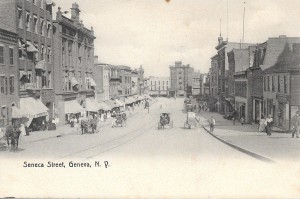
Postcard of Seneca St. with 1907 postmark, showing horse-drawn carriages and pedestrians. From the personal collection of Chris Woodworth.
In the early days of the Opera House, carriages may have delivered patrons who didn’t live close enough to walk, as you can see from this early postcard of Seneca St., postmarked 1907.
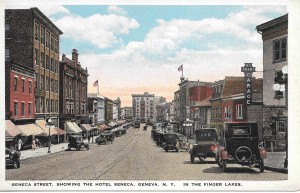
Undated Postcard of Seneca St., showing early automobiles and the trolley line. From the personal collection of Chris Woodworth.
Seneca St. boasted a trolley line for several decades. The trolleys in Geneva could connect travelers to various locations within Geneva as well as to neighboring towns. There was even a line that could deliver riders to Rochester! For more information on the transportation history of Geneva, including trolleys, check out “How Railroads Shaped Geneva” by the Geneva Historical Society or the transcript of a 1987 Geneva Historical Society lecture by Bud Smith on railroad and trolley history in Geneva.
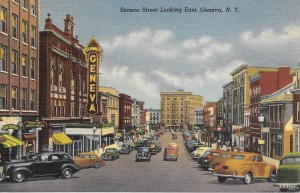
Postcard of Seneca St., likely 1940s or 1950s, showing automobile congestion. From the personal collection of Chris Woodworth.
Automobiles eventually took over as the main form of transportation. As you can see from the mid-century postcard, the trolley line on Seneca St. eventually disappeared. Parked cars line Seneca Street, which would eventually get widened through the urban renewal process a decade or two after this image was likely taken. Over the years how patrons arrived at The Smith may have shifted. One element remains the same: the moment the lights dim in the auditorium, audiences are transported yet again to other worlds through live performance or film.
Works Cited
“How Railroads Shaped Geneva.” Geneva Historical Society. Exhibit March 2012-April 2013. https://genevahistoricalsociety.com/exhibits/railroads-shaped-geneva/ Accessed 16 Sept. 2019.
Marks, John. “Building A Better Geneva: Urban Renewal, Part I.” Geneva Historical Society Blog. 16 Oct. 2015. https://genevahistoricalsociety.com/buildings-and-places/building-a-better-geneva-urban-renewal-part-i/. Accessed 16 Sept. 2019.
—. “Building A Better Geneva: Urban Renewal, Part II.” Geneva Historical Society Blog.13 Nov. 2015. https://genevahistoricalsociety.com/buildings-and-places/building-a-better-geneva-urban-renewal-part-ii/. Accessed 16 Sept. 2019.
Photograph (undated) of 1949 Kaiser Automobile in Smith Lobby. Appears in Gerald Fowler’s Scrapbook, housed in the Geneva Historical Society Archives.
Photograph (undated) of Hudson Automobile in Smith Lobby. Appears in Gerald Fowler’s Scrapbook, housed in the Geneva Historical Society Archives.
Smith, Bud. “Railroads & Trolley Lines of Geneva N.Y.” Lecture delivered 17 Feb. 1987 for Geneva Historical Society. http://fglk.railfan.net/history.html. Accessed 16 Sept. 2019.
Would you like to be involved in creating Celebrate The Smith: An Immersive Theatre Event, The Smith’s 125th Birthday Celebration? We need actors, directors, writers, stage managers, and hosts. No theatre experience needed!
Prefer to join us as an audience member? Click here for tickets and information.